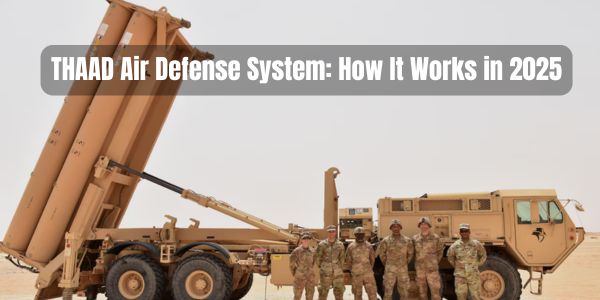The THAAD air defense system is a U.S.-made shield that stops enemy ballistic missiles before they can strike. Whether it’s protecting cities or troops, this high-flying missile defense system is a game-changer. But what is the THAAD air defense system, and how does it work in 2025? Let’s explain it simply.
What Is the THAAD Air Defense System?
The THAAD air defense system—short for Terminal High Altitude Area Defense—is built to stop ballistic missiles, those fast rockets that soar high and then dive toward targets like bases or towns. Made by Lockheed Martin for the U.S. Missile Defense Agency, THAAD catches these missiles in their final “terminal” phase, smashing them mid-air. It’s a key part of U.S. missile defense, working both inside and outside Earth’s atmosphere.
Explainer: Decoding BIMSTEC’s 21-Point Action Plan from the Bangkok Summit 2025
BIMSTEC at a Crossroads: Can the Bay of Bengal Bloc Seize Its Moment?
Explore Meta’s Latest Innovation: Llama 3 Open-Source AI Models
How Does THAAD Work?
Unlike old-school defenses that explode, the THAAD air defense system uses “hit-to-kill” technology. Imagine a bullet hitting another bullet—it slams into the missile with pure force, breaking it apart. Here’s how it happens:
- Detection: A powerful radar spots the missile from miles away.
- Tracking: A control system maps its path and plans the intercept.
- Launch: A truck fires an interceptor missile into the sky.
- Impact: The interceptor crashes into the target, stopping it cold.
This method keeps debris low, making THAAD a clean, effective U.S. missile defense tool.
Parts of the THAAD System
The THAAD air defense system has four main pieces:
- Interceptor Missile: A 20-foot, 1,500-pound rocket that flies over Mach 8 to hit ballistic missiles. Each truck holds eight.
- Launcher: Mobile trucks carry 48–72 interceptors per battery (six to nine trucks).
- Radar (AN/TPY-2): Sees threats up to 1,800 miles away—think Los Angeles to Denver—and guides the interceptors.
- Fire Control: The brain linking radar, launchers, and other defenses like Patriot.
A THAAD battery, run by 95 U.S. soldiers, can be flown anywhere on a C-17 plane, making it a flexible ballistic missile defense system.
The History of THAAD
The THAAD air defense system started after the 1991 Gulf War, when Iraq’s Scud missiles showed the U.S. needed better protection. Begun in 1987, early tests flopped—six misses by 1999. After fixes, it nailed its first success in 1999 and went live in 2008. Today, it’s 18-for-18 in tests, a star in U.S. missile defense.
Where Is THAAD Deployed in 2025?
With eight batteries (a ninth due late 2025), THAAD guards key spots:
- Guam: Since 2013, blocking North Korean threats.
- South Korea: In Seongju since 2017, despite China’s radar worries.
- UAE: Stopped a Houthi missile in 2022—its first combat win.
- Israel: Deployed October 2024, downed six Houthi missiles by March 2025.
- Saudi Arabia: Part of a $15 billion deal, active against regional risks.
In 2025, THAAD deployments shifted to the Middle East (March 30) to counter Houthi attacks, per Army updates.
Why THAAD Stands Out
The THAAD air defense system shines because:
- High Reach: Hits missiles 93 miles up, above Patriot’s range.
- Wide Protection: Shields big areas like cities or bases.
- Perfect Record: 18 test wins, no misses since 2006.
- Teamwork: Pairs with other U.S. missile defense systems.
THAAD’s Limits
It’s not flawless:
- High Targets Only: Misses low-flying drones or cruise missiles.
- Limited Shots: 48–72 interceptors per battery can run out.
- Costly: Over $1 billion per battery, with just eight available.
- U.S. Crews: Only American soldiers operate it, tying up troops.
THAAD 2025 Updates: Why It Matters Now
In 2025, the THAAD air defense system is busier than ever. Israel’s six Houthi intercepts (latest December 27, 2024) show it works in real fights. The U.S. added 12 interceptors in February 2025 and moved batteries to the Middle East in March, per Army reports, as threats from Iran, North Korea, and Yemen grow. It’s a vital ballistic missile defense tool, but it needs upgrades for new, twisty hypersonic missiles.
Final Take
The THAAD air defense system is a sky-saving hero—fast, smart, and tough. It’s not cheap or perfect, but it’s a cornerstone of U.S. missile defense in 2025, keeping danger at bay one hit at a time.

